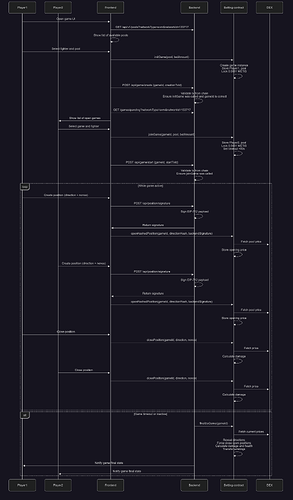Project Name
MortalCoin: Trading Simulation Fighting Game – Outtrade Your Opponent to Win
Problem Statement
The Web3 space thrives on trading, competition, and game-like experiences - yet these elements remain largely disconnected. Trading is typically solitary and chart-driven, while gaming and meme culture live in separate silos.
We see an opportunity to unify these dimensions into a real-time, skill-based PvP/PvE battleground - where cryptocurrencies come to life as unique, playable characters.
Inspired by the speed of Hyperliquid, the strategic depth of poker, and the intensity of Mortal Kombat, our game turns speculative trading into an engaging, competitive, and entertaining experience.
Solution Overview
MortalCoin transforms crypto trading into a real-time combat game, where players “fight” by outperforming their opponents in simulated market environments using real price feeds. Each cryptocurrency is represented as a unique character, adding personality and emotional attachment to assets.
During the hackathon, we plan to make significant progress on three key fronts:
- Continue the transition from a MVP Telegram Mini App to a full-featured Web App.
- Finalize the alpha release of our core PvP and PvE trading game modes, ensuring smooth real-time gameplay.
- Continue on-chain R&D and deploy our first on-chain logic using Metis’s Hyperion, laying the foundation for trustless game mechanics where key gameplay elements can be cryptographically verified.
Our broader goal is to demonstrate that a fast-paced trading game can operate with minimal latency while preserving the transparency, integrity, and verifiability of Web3 systems.
Our uniqueness lies in blending real-time trading simulation with PvP battle mechanics and on-chain adjudication (TBD) - framed as a meme-powered arena where crypto assets are reimagined as animated, playable characters.
Project Description
MortalCoin is a real-time PvP/PvE crypto trading game where players battle using simulated trades based on live market data. Think Mortal Kombat meets Hyperliquid, with cryptocurrencies personified as unique, playable fighters. Each battle simulates a short trading session where players choose strategies and try to outtrade their opponents.
The simplified gameplay MVP has already launched as a Telegram Mini App (Season 1 started June 1st): @themortalcoin_bot, with around 10000 users played so far. We’re now expanding to web, integrating EVM functionality.
Website: https://mortalcoin.app
Hyperhack Hackathon web version build (wip - you can fight an AFK ghost for now, just click “Start Fight”): https://stage.mortalcoin.app
Gameplay teaser: https://www.youtube.com/shorts/04vbwJzEBio
Whitepaper draft: https://docs.mortalcoin.app
Deck draft: https://www.canva.com/design/DAGsSaY6o4g/jE94ckGrT4ahyOBNykFpFw/edit
Community Engagement Features
We have several features designed to drive virality and user engagement:
- Leaderboards – We tested time-limited, incentivized leaderboards in the Telegram Mini App, attracting nearly 4,000 players in June. This will be brought to the web version.
- Referral System – Already live in Telegram and planned for the web version.
- Missions – Tasks like “Win X fights,” “Win with a specific coin,” “Refer a friend,” and daily/weekly challenges will carry over to web.
- Daily Free Tickets – Players get free tickets (needed for battles) daily, boosting retention and routine engagement.
We use an internal soft currency called tickets, required to play PvP and PvE battles. Tickets can be earned through missions, referrals, daily claims, or purchases, forming the foundation of our progression system.
Players also earn MortalPoints (MP) by winning fights and completing challenges. MP reflects player skill and activity, and will later be spendable in the in-game store or used in token/NFT-based incentives like tournaments or airdrops.
Looking ahead, we also plan to introduce an ELO rating system with ranked divisions—adding a competitive layer that rewards performance and progression over time.
Getting Involved
Everyone is welcome to join our Telegram chat: Telegram: View @mortalcoin_chat and share suggestions or ideas.
Right now, we’re in the middle of transitioning our backend from Telegram Mini App support to a full web experience. We anticipate a playable web version with engaging gameplay and on-chain mechanics to be ready by the end of July - and we’ll need plenty of help testing and playing! ![]()
